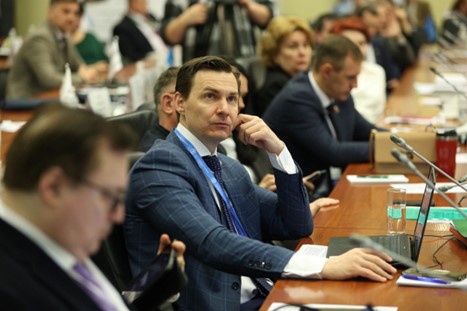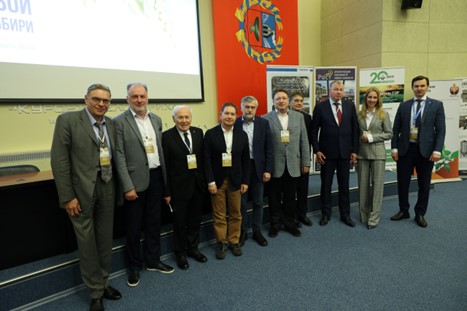The Altai arable land at the start of the new season: FAO at the main grain forum in Siberia

©Photo: © The Winter Grain Conference Press Service
On February 28 – March 1, the XVII Winter Grain Conference was held in the city of Belokurikha in Altai Krai. The event that is traditionally held with support of the Altai Krai government and the Ministry of agriculture of the Russian Federation was organized by the Altai Grain Processors Union, the analytical company ProZerno and the Institute for Agricultural Market Studies (IKAR).
The experts discussed the initial results of the current grain season, the quality of the wheat harvest in 2023, the forecasts for the economic development of the Russian Federation in the near future and the main trends in the key global sales markets.
Opening the Conference, Minister of Agriculture of the Altai Krai Sergey Mezhin reported on the results of the 2023 cropping season. “We entered the top ten regions of the Russian Federation for grain production, although due to adverse weather conditions, the harvest decreased by 20%, and the total yield turned out to be 3 quintals per hectare less compared to 2022. At the same time, the region remains among the leaders in buckwheat – the production volume amounted to 835 thousand tonnes, which is 13% higher than last year, and the total share of the region in the Russian market for this crop reached 60%,” Sergey Mezhin stressed.
According to the Ministry of agriculture of the Altai Krai, the grain production in the region still exceeds the internal need estimated at 3.5 million tonnes. By the end of 2023, 1.5 million tonnes of grain were exported, composed of wheat, buckwheat, barley and legumes. “In the ranking of regions of the Siberian Federal District, the Altai Krai is in second place in terms of exports with an indicator of about USD 600 million,” the minister concluded.
Igor Shpakov, Consultant of the Moscow Liaison Office with the Russian Federation, provided statistical and prospective information on the global grain market concerning major commodity-producing countries and regions.
“Economic shocks, as the analysis of the results of last year showed, are a more significant cause of the spread of hunger than internal and regional armed conflicts. As a result, despite the decrease in world food prices year-on-year, domestic prices in many countries remain high in the context of low foreign-exchange reserves and the lack of the possibility to build up the purchase of imported food commodities. Moreover, such extreme weather events as heavy rains, tropical storms, cyclones, floods, droughts and increased climate variability also remain significant negative factors that disrupt food security.

FAO therefore puts much emphasis on the grain sector which has critical importance for the economies of a wide range of countries, ensuring their food security, export revenues, agricultural development and raw materials base for the allied industry sectors. It is for that reason that for many years already the Organization has the operating Agricultural Market Information System (AMIS) that provides the most recent information on the production of, consumption of, trade in and stocks of the main crops,” the expert explained.
Speaking about the peculiarities of this season’s harvest, Igor Shpakov noted that in 2023, “climatic swings” led to Argentina significantly reducing exports of major grain commodity items due to a low harvest, which was severely affected by months of drought. However, at the moment, the country has a very good chance of getting a close to record harvest of corn and soybeans.
Commenting on the situation in the global rice market, the FAO representative noted that over the past decade, India has become the world’s largest exporter of this grain crop with a market share of 40%. However, against the background of rising domestic prices in the summer of 2023, it had to impose a ban on the export of most varieties of white rice, with the exception of basmati. As a result, rice supplies from India decreased by 80%, which keeps world prices for this crop at a high level (an increase of 21% in 2023).
“According to the FAO forecast, in the upcoming season, the volume of grain consumption in the world is expected to reach 2 billion 822 million tonnes (of which fodder-grain crops will account for 1.5 billion tonnes), which will be 1.2% higher than the 2022-2023 season indicator. At the same time, global trade in cereals, except corn, is declining. The projected volume of trade in them in the world in the 2023/24 season is estimated at 480 million tonnes, which is 0.8% higher than the same indicator of the previous period,” Igor Shpakov said in conclusion.
Anrey Klepatch, Main economist of the National Development Corporation of the Bank for Development and Foreign Economic Affairs of the Russian Federation, shared the forecast of the development of the Russian economy in 2024. According to the expert, the main economic indicators in the country allow us to hope for positive dynamics. “We are witnessing a strong wave of consumer demand in the service sector as well as through the development of public catering which grew even more than retail trade. A shortage of labour and an increase in real wages has led us to an increase in consumer demand. This year, the increase in household incomes will also be quite noticeable.”
Andrey Klepatch noted in particular that the last year inflation defied expectations, which was the result not so much of economy overheating and increased incomes of the population, as the effect of the fall in the rouble exchange rate. The stabilization of the national currency depends both on increased credit rates and on the mandatory sale by export companies of part of their foreign exchange earnings. “In general, it can be stated that the Russian economy adapts skillfully to the emerging external conditions, but in the foreseeable future the government will have to deal with new challenges and be able to promptly respond to them,” the speaker pointed out.
Evgeny Gavrilenkov, GKEM Analytica partner, editor-in-chief of the Economic journal of the HSE University, noted that investments in the national economy have been growing at a fairly high rate for the last three years and are likely to increase further this year, outpacing the dynamics of GDP recovery.
“At the same time, the idea that the strengthening of the rouble somehow helps to slow down inflation does not always work. The rouble exchange rate in the current situation should allow the government to collect enough revenue, primarily regarding oil and gas. In this sense, the correction of the rouble exchange rate will continue to partially compensate for the significantly increased budget expenditures,” the analyst concluded.
Dmitry Rylko, Director General of the Institute for Agricultural Market Studies (IKAR), in a detailed report on the results of the grain year, stressed that the driver of the Russian agricultural exports is currently cereals and flour. In addition, the supply of meat and ready-made meat products is growing, thanks to which Russia has become a net exporter in this category in USD for the first time in history.
“We have been net exporters by weight of meat products for a long time, but in 2023, meat exports exceeded imports by value. Most of all, USD 8 billion of this food goes to China,” the expert noted.
The expert emphasized that this year, from February 15 (the beginning of the export quota) until the end of June, Russian companies will have to export 19 million tonnes of wheat. “This amount is a huge volume by itself – last year we exported 18.4 million tonnes, and it was already a record back then. In the remaining time Russian agrarians will have to export even more to reach the planned figure of 52 million tonnes, which will allow to relieve the rather strained current balance for wheat,” Dmitry Rylko precized.
Vladimir Petrichenko, Director of ProZerno company, told the audience in detail about the prospects for the end of the 2023-2024 grain season. “Rosstat just last night published the final harvest results,” the speaker noted, “The official data account for 144.9 million tonnes of grains and pulses. The Russian Federation reached the second result for wheat – 16.62 million tonnes. Due to the increase in flour production that began in 2022, its exports may exceed 1 million tonnes this season. Currently, most of the Russian flour is exported to Afghanistan.”
The expert noted that the achieved rate of exports is encouraging: “We are 8-9 million tonnes ahead of last year’s figures. Although there is some concern here. Thus, the three leaders in imports from Russia are as follows: Egypt, Türkiye and Iran. Unfortunately, these countries have a relatively low solvency. For instance, at GASC (Egypt) tenders, Russian wheat is purchased with a deferred payment of 270 days,” stated the head of the analytical agency.
“On the whole, if all the factors work out correctly, then the free grain market in Russia at the end of the season will have about 13-14 million tonnes of final reserves, of which 7-8 million tonnes will be wheat. This is very good, and quite comparable to 2018-2020. In the next two to three months, the picture will gradually change. We now have a low buyer’s market that is “unpleasant” for prices, but in the foreseeable future the necessary balance will be achieved, and grain prices can begin a smooth rebound,” Vladimir Petrichenko summed up.
Aleksey Maslov, professor, director of the Institute of Asian and African Countries at Lomonosov Moscow State University, described the specificities of the work in the agrifood markets of China and Southeast Asia. “Speaking about the collaboration between the Russian Federation and China, we need to understand that both countries are in contact with the most underdeveloped regions. Our main partners are northeastern provinces of China, namely three regions with a total population of 94 million people.
Russian enterprises, primarily from the borderlands, should enter the markets of the central regions of China where a richer and more economically active population lives. To do this, we need to rebuild logistics, and here the solution of the existing issues is on our side, since the Chinese market is still open to foreigners, including Russian businessmen. Currently, Pacific ports, through which goods can be delivered to the more prosperous southern and coastal regions of the People’s Republic of China, are acquiring a greater role,” Aleksey Maslov highlighted in conclusion.
The opinions and concerns expressed by the participants during the conference reflected the overall picture of the situation in the international grain market. The continued decline in world prices for the main commodity items for wheat, corn and barley is forcing participants in commodity chains and producers to think about diversifying production and reorienting to marginal crops, in particular legumes and oilseeds.
In the Russian Federation agrarians also additionally take into account the significantly increased cost of production over the entire range of crop production.
In this regard, in addition to verified fertilizer application schemes and optimization of the use of plant protection products that support productivity in difficult conditions, actively implemented solutions based on digital technologies are at the forefront. It is not enough to grow a good harvest for a successful agribusiness. It is important to sell it successfully – at a bargain price and without intermediaries, which makes this area an effective tool in increasing the profitability of any farm.
* * *
The background information:
The Winter Grain Conference is one of the largest annual agrarian forums in Siberia. This professional discussion platform has been created to shape Russian grain industry enterprises development strategies, make effective management decisions through close business contacts and share relevant market information.

